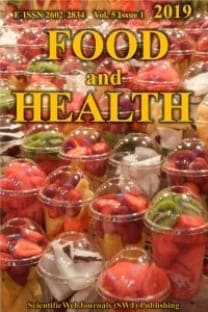Prediction of growth kinetics of Pseudomonas spp. in meat products under isothermal and non-isothermal storage conditions
Prediction of growth kinetics of Pseudomonas spp. in meat products under isothermal and non-isothermal storage conditions
The main objective of the present study was to develop and validate a new alternative modelling method to predict the shelf-life of food products under non-isothermal storage conditions. The bacterial growth data of the Pseudomonas spp. was extracted from published studies conducted for aerobically-stored fish, pork and chicken meat and described with two-step and one-step modelling approaches employing different primary models (the modified Gompertz, logistic, Baranyi and Huang models) under isothermal storage temperatures. Temperature dependent kinetic parameters (maximum specific growth rate ‘µmax’ and lag phase duration ‘λ’) were described as a function of storage temperature via the Ratkowsky model integrated with each primary model. The Huang model based on the one-step modelling approach yielded the best goodness of fit results ($RMSE = 0.451 and adjusted-R^2 = 0.942$) for all food products at isothermal storage conditions, therefore, was also used to check it’s the prediction capability under non-isothermal storage conditions. The differential form of the Huang model provided satisfactorily statistical indexes ($1.075 > B_f > 1.014 and 1.080 > A_f > 1.047$) indicating reliably being able to use to describe the growth behaviour of Pseudomonas spp. in fish, pork and chicken meat subjected to non-isothermal storage conditions.
___
- Baranyi, J., Roberts, T.A. (1994). A dynamic approach to predicting bacterial growth in food. International Journal of Food Microbiology, 23, 277-294. https://doi.org/10.1016/0168-1605(94)90157-0
- Bovill, R.A., Bew, J., Baranyi, J. (2001). Measurements and predictions of growth for Listeria monocytogenes and Salmonella during fluctuating temperature: II. Rapidly changing temperatures. International Journal of Food Microbiology, 67, 131-137. https://doi.org/10.1016/S0168-1605(01)00446-9
- Bruckner, S. (2010). Predictive shelf life model for the improvement of quality management in meat chains. PhD thesis.
- Bruckner, S., Albrecht, A., Petersen, B., Kreyenschmidt, J. (2013). A predictive shelf life model as a tool for the improvement of quality management in pork and poultry chains. Food control, 29, 451-460. https://doi.org/10.1016/j.foodcont.2012.05.048
- Buchanan, R.L., Whiting, R.C., Damert, W.C. (1997). When is simple good enough: a comparison of the Gompertz, Baranyi, and three-phase linear models for fitting bacterial growth curves. Food Microbioogy, 14, 313-326. https://doi.org/10.1006/fmic.1997.0125
- Dominguez, S.A., Schaffner, D.W. (2007). Development and validation of a mathematical model to describe the growth of Pseudomonas spp. in raw poultry stored under aerobic conditions. International Journal of Food Microbiology, 120, 287-295. https://doi.org/10.1016/j.ijfoodmicro.2007.09.005
- Ghollasi-Mood, F., Mohsenzadeh, M., Hoseindokht, M.R., Varidi, M. (2017). Quality changes of air-packaged chicken meat stored under different temperature conditions and mathematical modelling for predicting the microbial growth and shelf life. Journal Food Safety, 37, e12331. https://doi.org/10.1111/jfs.12331
- Huang, L. (2008). Growth kinetics of Listeria monocytogenes in broth and beef frankfurters Determination of lag phase duration and exponential growth rate under isothermal conditions. Journal of Food Science, 73, e235-242. https://doi.org/10.1111/j.1750-3841.2008.00785.x
- Huang, L. (2017). IPMP Global Fit–A one-step direct data analysis tool for predictive microbiology. International Journal of Food Microbiology, 262, 38-48. https://doi.org/10.1016/j.ijfoodmicro.2017.09.010
- Jewell, K. (2012). Comparison of 1-step and 2-step methods of fitting microbiological models. International Journal of Food Microbiology, 160, 145-161. https://doi.org/10.1016/j.ijfoodmicro.2012.09.017
- Koutsoumanis, K. (2001). Predictive modeling of the shelf life of fish under nonisothermal conditions. Applied and Environmental Microbiology, 67, 1821-1829. https://doi.org/10.1128/AEM.67.4.1821-1829.2001
- Le Marc, M., Plowman, J., Aldus, C. F., Munoz-Cuevas, M., Baranyi, J., Peck, M.W. (2008). Modelling the growth of Clostridium perfringens during the cooling of bulk meat. International Journal of Food Microbiology, 128, 41-50. https://doi.org/10.1016/j.ijfoodmicro.2008.07.015
- Lytou, A., Panagou, E.Z., Nychas, G.J.E. (2016). Development of a predictive model for the growth kinetics of aerobic microbial population on pomegranate marinated chicken breast fillets under isothermal and dynamic temperature conditions. Food Microbioogy, 55, 25-31. https://doi.org/10.1016/j.fm.2015.11.009
- Martino, K.G., Marks, B.P. (2007). Comparing uncertainty resulting from two-step and global regression procedures applied to microbial growth models. Journal of Food Protection,70, 2811-2818. https://doi.org/10.4315/0362-028X-70.12.2811
- Milkievicz, T., Badia, V., Souza, V. B., Longhi, D. A., Galvão, A. C., da Silva Robazza, W. (2020). Development of a general model to describe Salmonella spp. growth in chicken meat subjected to different temperature profiles. Food Control, 112, 107151. https://doi.org/10.1016/j.foodcont.2020.107151
- Pérez-Rodríguez, F., Valero, A. (2013). Predictive Microbiology in Foods. Springer, New York. ISBN: 978-1-4614-5520-2 https://doi.org/10.1007/978-1-4614-5520-2
- Ratkowsky, D.A., Olley, J., McMeekin, T.A., Ball, A. (1982). Relationship between temperature and growth rate of bacterial cultures. Journal of Bacterioogy, 149, 1-5. https://doi.org/10.1128/JB.149.1.1-5.1982
- Robinson, T.P., Ocio, M.J., Kaloti, A., Mackey, B.M. (1998). The effect of the growth environment on the lag phase of Listeria monocytogenes. International Journal of Food Microbiology, 44, 83-92. https://doi.org/10.1016/S0168-1605(98)00120-2
- Ross, T. (1996). Indices for performance evaluation of predictive models in food microbiology. Journal of Applied Bacterioogy, 81, 501-508. https://doi.org/10.1111/j.1365-2672.1996.tb03539.x
- Tarlak, F. (2020). Development and validation of one-step modelling approach for prediction of mushroom spoilage. Journal of Food and Nutrition Research, 59(4), 281-289.
- Whiting, R.C. (1995). Microbial modeling in foods. Critical Reviews in Food Science and Nutrition, 35, 467-494. https://doi.org/10.1080/10408399509527711
- Zwietering, M. H., De Wit, J. C., Cuppers, H. G. A. M., van't Riet, K. (1994). Modeling of bacterial growth with shifts in temperature. Applied and Environmental Microbiology, 60, 204-213. https://doi.org/10.1128/AEM.60.1.204-213.1994
- Zwietering, M.H, Jongenburger, I., Rombouts, F.M, van’t iet, K. (1990). Modeling of the bacterial growth curve. Applied and Environmental Microbiology, (56), 1875-1881. https://doi.org/10.1128/AEM.56.6.1875-1881.1990
- ISSN: 2602-2834
- Yayın Aralığı: Yılda 4 Sayı
- Başlangıç: 2018
- Yayıncı: ScientificWebJournals (SWJ) Özkan Özden
Sayıdaki Diğer Makaleler
Evaluation of the effect of cooling on the microbiological quality of lamb carcasses
Pelin KOÇAK KIZANLIK, Yasemin YALÇIN, Cemil ŞAHİNER, Ergün Ömer GÖKSOY
Gıda ve su kaynaklı önemli viral enfeksiyonların güncel durumu ve korunma stratejileri
Seran TEMELLİ, Ayşegül EYİGÖR, Ahmet Gökhan COŞKUN, Ayşegül DEMİRCİOĞLU
Essential oil profile of six spontaneous hybrids from male sterile Salvia officinalis L.
Determination of some minerals and heavy metal levels in Urfa cheese and cow's milk
Serap KILIÇ ALTUN, Mehmet Emin AYDEMİR
Serap COŞANSU, Şeyma Şeniz ERSÖZ
Tarihin gelişim sürecinde Türk yemek kültürü ve beslenme alışkanlıklarının değişimi
